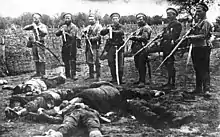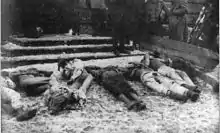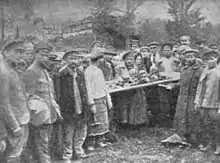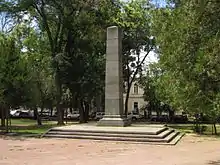White Terror (Russia)
The White Terror in Russia refers to the organized violence and mass killings carried out by the White Army during the Russian Civil War (1917–23). It began after the Bolsheviks seized power in November 1917, and continued until the defeat of the White Army at the hands of the Red Army. The White Army fought the Red Army for power, which engaged in its own Red Terror. According to some Russian historians, the White Terror was a series of premeditated actions directed by their leaders,[1][2][3] although this view is contested. Estimates for those killed in the White Terror vary, from between 20,000 and 100,000 people[4] as well as much higher estimates of 300,000 deaths.[5]

Southern and Western Russia


An important member of the White Terror was Lavr Kornilov. During the Ice March in the south of Russia, Kornilov said: "I give you a very cruel order: do not take prisoners! I accept responsibility for this order before God and the Russian people." He promised, "The greater the terror, the greater our victories."[6] He vowed that, "We must save Russia, even if we have to set fire to half the country and shed the blood of three-fourths of all Russians."[6] On another occasion, however, Kornilov said that prisoners should be taken care of, saying, "We do not make war against the wounded."[7]
According to N. Bogdanov, a participant in the Ice March,
After receiving information about the Bolsheviks, the commander of the captured detachment was shot. Under Colonel Corwin Krukovsky, there was some especially painful cruelty. I know of many cases when under the influence of hatred for the Bolsheviks, the officers assumed the duties of shooting the captured volunteers. The executions were necessary because under the conditions in which the Volunteer Army had to move, prisoners could not be taken.[7]
Bogdanov cited another occasion, however, where Red officers were tried and cleared as having acted under duress.[7]
After Kornilov was killed in April 1918, the leadership of the Volunteer Army passed to Anton Denikin. During the Denikin regime, the press regularly urged violence against Jews. For example, a proclamation by one of Denikin's generals incited people to "arm themselves" in order to extirpate "the evil force which lives in the hearts of Jew-communists." In the small town of Fastov alone, Denikin's Volunteer Army murdered over 1,500 Jews, mostly the elderly, women, and children. An estimated 100,000 to 150,000 Jews in Ukraine and southern Russia were killed in pogroms perpetrated by Denikin's forces as well as Petlyura's nationalist-separatists.[8] Hundreds of thousands of Jews were left homeless and tens of thousands became victims of serious illness.[9]
In the Don Province, the Soviet government was displaced by a regime headed by Pyotr Krasnov formed in April 1918. According to Walter Laqueur, more than 45,000 people were shot or hanged by Krasnov's White Cossack regime, which lasted until the Red Army conquered the region following their victory at Tsaritsyn.
Mass executions occurred in 1918 in territories under White occupation. In one incident, commander of the 3rd Division of the Volunteer Army, M. Drozdovsky, gave an order to shoot more than 1,000 captured prisoners.
In 1918 when the Whites controlled the Northern Territory with a population of about 400,000 people, more than 38,000 were sent to prisons. Of those, about 8,000 were executed while thousands more died from torture and disease.[10]
Eastern Russia
In November 1918, after seizing power in Siberia, Admiral Kolchak pursued a policy of persecuting revolutionaries as well as Socialists of several factions. Kolchak's government issued a broadly worded decree on 3 December 1918 revising articles of the criminal code of Imperial Russia "in order to preserve the system and rule of the Supreme Ruler". Articles 99 and 100 established capital punishment for assassination attempts on the Supreme Ruler and for attempting to overthrow the authorities. Under Article 103, "insults written, printed, and oral, are punishable by imprisonment". Bureaucratic sabotage under Article 329 was punishable by hard labor from 15 to 20 years.[1] Additional decrees followed, adding more power. On 11 April 1919, the Kolchak government adopted Regulation 428, "About the dangers of public order due to ties with the Bolshevik Revolt", which was published in the Omsk newspaper Omsk Gazette (no. 188 of 19 July 1919). It provided a term of 5 years of prison for "individuals considered a threat to the public order because of their ties in any way with the Bolshevik revolt". In the case of unauthorized return from exile, there could be hard labor from 4 to 8 years. Articles 99-101 allowed the death penalty, forced labor and imprisonment, and repression by military courts, and it also imposed no investigation commissions.[1]
An excerpt from the order of the government of Yenisei county in Irkutsk province, General. S. Rozanov said:
Those villages whose population meets troops with arms, burn down the villages and shoot the adult males without exception. If hostages are taken in cases of resistance to government troops, shoot the hostages without mercy.[1]
A member of the Central Committee of the Right-wing Socialist Revolutionaries, D. Rakov wrote about the terror of Kolchak's forces:
Omsk just froze in horror. At a time when the wives of dead comrades, day and night looked in the snow for bodies, I was unaware of the horror behind the walls of the guardhouse. At least 2500 people were killed. Entire carts of bodies were carried to a city, like winter lamb and pork carcasses. Those who suffered were mainly soldiers of the garrison and the workers.[11]
In March 1919 Admiral Kolchak himself demanded one of his generals to "follow the example of the Japanese who, in the Amur region, had exterminated the local population".[6] Kolchak's regime also used mass floggings,[12] especially with rods.[13] Kolchak issued orders to raze to the ground whole villages.[13] In a few Siberian provinces, 20,000 farms were destroyed and over 10,000 peasant houses burned down.[13] Kolchak's regime destroyed bridges and blew up water stations.[13]
In the Urals, Siberia, and the Far East, extraordinary cruelty was practiced by several Cossack warlords: B. Annenkov, A. Dutov, G. Semyonov, and I. Kalmykov. During the trial against Annenkov, there was testimony about the robbing peasants and atrocities under the slogan: “We have no restrictions! God is with us and Ataman Annenkov: slash right and left!”.[14] In September 1918, during the suppression of peasant uprisings in Slavgorod county, Annenkov tortured and killed up to 500 people. The village of Black Dole was burned down, after which peasants were shot, tortured, and hanged on pillars, including the wives and children of the peasants. Girls of Slavgorod and surrounding areas were brought to Annenkov's train, raped, and then shot. According to an eyewitness, Annenkov behaved with brutal torture: victims had their eyes gouged and tongues and strips of their back cut off, were buried alive, or tied to horses. In Semipalatinsk, Annenkov threatened to shoot every fifth resident if the city refused to pay indemnities.[15]
On May 9, 1918, after Ataman Dutov captured Alekasandrov-Gai village, nearly 2,000 men of the Red Army were buried alive. More than 700 people of the village were executed. After capturing Troitsk, Orenburg, and other cities, a regime of terror was installed. One prison in Orenburg contained over 6,000 people, of whom 500 were killed just during interrogations. In Chelyabinsk, Dutov's men executed or deported to Siberian prisons over 9,000 people. In Troitsk, Dutov's men in the first weeks after the capture of the city shot about 700 people. In Ileka they killed over 400. These mass executions were typical of Dutov's Cossack troops.[16] Dutov's Executive order of 4 August 1918 imposed the death penalty for evasion of military service and for even passive resistance to authorities on its territory.[15] In one district of the Ural region in January 1918, Dutov's men killed over 1,000 people.[16] On 3 April 1919, the Cossack warlord ordered his troops to shoot and take hostages for the slightest display of opposition. In the village of Sugar, Dutov's men burned down a hospital with hundreds of Red Army patients.[16]
The Semenov regime in Transbaikalia was characterized by mass terror and executions. At the Adrianovki station in summer of 1919, more than 1,600 people were shot. Semenov himself admitted in court that his troops burned villages. Eleven permanent death houses were set up, where refined forms of torture were practiced.[17] Semyonov personally supervised the torture chambers, during which some 6,500 people were murdered.[18]
Major General William S. Graves, who commanded American occupation forces in Siberia, testified that:
Semeonoff and Kalmikoff soldiers, under the protection of Japanese troops, were roaming the country like wild animals, killing and robbing the people, and these murders could have been stopped any day Japan wished. If questions were asked about these brutal murders, the reply was that the people murdered were Bolsheviks and this explanation, apparently, satisfied the world. Conditions were represented as being horrible in Eastern Siberia, and that life was the cheapest thing there. There were horrible murders committed, but they were not committed by the Bolsheviks as the world believes. I am well on the side of safety when I say that the anti-Bolsheviks killed one hundred people in Eastern Siberia, to every one killed by the Bolsheviks.[19]
In literature
Many Russian authors wrote about the heroism of the Russian people in combating the White Terror. Novels include Furmanov's Chapaev, Serafimovich's The Iron Flood, and Fadeyev's The Rout. Many of the early short stories and novels of Sholokhov, Leonov, and Fedin were devoted to this theme.[20]
Nikolai Ostrovsky's autobiographical novel[21] How the Steel was Tempered documents episodes of the White Terror in western Ukraine by anti-Soviet units.
Memorials to victims of the White Terror

In Russia, Ukraine, Belarus, and elsewhere, a significant number of monuments are dedicated to victims of the White Terror. Most monuments were placed on the mass graves created by the terror.[22]
Since 1920, the central square in Volgograd has been called the "Square of Fallen Fighters", where the remains of 55 victims of the White Terror are buried. A monument established in 1957 in black and red granite has an inscription: "To the freedom fighters of Red Tsaritsyn. Buried here are the heroic defenders of Red Tsaritsyn brutally tortured by White Guard butchers in 1919."[22]
A monument to victims of the White Terror stands in Vyborg. It was erected in 1961 near the Leningrad Highway to commemorate 600 people shot by machine gun.[23]
The "In Memory of Victims of the White Terror" monument in Voronezh is located in a park near the regional Nikitinskaia libraries. The monument was unveiled in 1920 on the site of public executions in 1919 by the troops of Mamantov.
In Sevastopol on the 15th Bastion Street, there is a "Communard Cemetery and victims of White terror". The cemetery is named in honor of the members of the Communist underground murdered by Whites in 1919–20.[24]
In the city of Slavgorod in Altai Krai, there is a monument for participants of the Chernodolsky Uprising and their families who fell victim to the White terror of Ataman Annekov.[25]
See also
References
Notes
- Цветков В. Ж. Белый террор — преступление или наказание? Эволюция судебно-правовых норм ответственности за государственные преступления в законодательстве белых правительств в 1917—1922 гг.
- А. Литвин. Красный и белый террор 1918—1922. — М.: Эксмо, 2004
- "Террор белой армии. Подборка документов" [Terror of the White Army, a selection of documents]. ОБЩЕСТВО АТЕИСТОВ (Atheist Society).
- Rinke, Stefan; Wildt, Michael (2017). Revolutions and Counter-Revolutions: 1917 and Its Aftermath from a Global Perspective. Campus Verlag. p. 58. ISBN 978-3593507057.
- Эрлихман, Вадим (2004). Потери народонаселения в XX веке. Издательский дом «Русская панорама». ISBN 5931651071.
- Mayer, p. 254
- Цветков, В. Ж. "Лавр Георгиевич Корнилов. Часть 3" [Lavr G. Kornilov. Part 3].
- Florinsky, Michael T. (1961). Encyclopedia of Russia and the Soviet Union. McGraw-Hill. p. 258. Retrieved 2009-07-22.
- Mayer, page unknown
- Litvin, p. 154
- Litvin, p. 160
- "Наша история" [Our History]. ГЛАВНОЕ УПРАВЛЕНИЕ МВД РОССИИ ПО СВЕРДЛОВСКОЙ ОБЛАСТИ (General Directorate of the Russian Ministry of Internal Affairs in the Sverdlovsk Region).
К концу 1918 года в восточных районах страны была установлена контрреволюционная диктатура адмирала Колчака. На захваченной белогвардейцами территории установился жесточайший террор. По своей жестокости колчаковщина превосходила даже царский режим. За время своего господства белогвардейцы замучили и расстреляла в Екатеринбургской губернии свыше 25 тысяч человек и около 200 тысяч подвергли порке. (By the end of 1918, Admiral Kolchak established a counter-revolutionary dictatorship in the eastern part of the country. Whites in the occupied territory committed the cruelest terror. In its cruelty Kolchak surpassed even the tsarist regime. During his reign, the Whites tortured and shot more than 25,000 people in Yekaterinburg province and about 200,000 were flogged.)
- Goykhbarg, A. (18 September 1920), Kolchakists on Trial, Soviet Russia: Official Organ of the Russian Soviet Government Bureau, III (July–December 1920), New York: The Russian Soviet Government Bureau, pp. 288–289, retrieved 2009-07-22
- Litvin, p. 174
- Litvin, p. 175
- Ratkovsky, p. 105
- словари. "Semenovshchina". Slovari.yandex.ru. Archived from the original on 2012-07-18. Retrieved 2009-07-22.
- Litvin, p. 176
- William S. Graves. America's Siberian Adventure, 1918–1920. Arno Press. 1971. p. 108
- R. N. Chakravarti & A. K. Basu. Soviet Union: Land and People. Northern Book Centre. 1987. p. 83
- "Музей Николая Островского г. Москва" [Nikolai Ostrovsky Museum, Moscow]. Archived from the original on 2017-07-16. Retrieved 2012-11-03.
- "Памятники и достопримечательности Волгограда" [Monuments and Landmarks of Volgograd]. МБУ "Городской информационный центр" (MBU "City Information Center").
- "Скульптура Выборга" [Sculpture of Vyborg]. Выборга (Vyborg).
- "Кладбище Коммунаров" [Cemetery of Communards (5th St. Bastion)]. Памятники Севастополя (The Monuments of Sevastopol).
- Cherniavsky, Svetlana (2006-09-19). "Памятник борцам революции, ставшим жертвами белого террора, нуждается в серьёзной реконструкции" [The monument to the fighters of the revolution victims of the White Terror, in need of serious renovation]. Славгородские вести (Slavgorodskaya Leader). Archived from the original on 2016-03-06. Retrieved 2013-10-02.
Bibliography
- Bisher, Jamie. White Terror: Cossack Warlords of the Trans-Siberian (Routledge, 2006)[1][2]
- Bortnevski, Viktor G. "White Administration and White Terror (The Denikin Period)." Russian Review (1993): 354–366. in JSTOR
- Holquist, Peter. "Violent Russia, Deadly Marxism? Russia in the Epoch of Violence, 1905-21." Kritika: Explorations in Russian and Eurasian History (2003) 4#3 pp: 627–652. online
- Lincoln, W. Bruce. Red victory: A history of the Russian Civil War (Da Capo Press, 1989)
- Mawdsley, Evan. The Russian Civil War (Pegasus Books, 2007)
- Mayer, Arno J. (2002). The Furies: Violence and Terror in the French and Russian Revolutions. Princeton, New Jersey: Princeton University Press. ISBN 0-691-09015-7.
- Novikova, Liudmila G. "Russia's Red Revolutionary and White Terror, 1917–1921: A Provincial Perspective." Europe-Asia Studies (2013) 65#9 pp: 1755–1770.
- Sanborn, Joshua. "The genesis of Russian warlordism: Violence and governance during the First World War and the Civil War." Contemporary European History (2010) 19#3 pp: 195–213.
In Russian
- А. Литвин. Красный и белый террор 1918–1922. — М.: Эксмо, 2004 [revised second edition; first edition published 1995][A. Litvin. Red and White Terror of 1918-1922. Eksmo, 2004] (in Russian)
- д. и. н. Цветков В. Ж. Белый террор — преступление или наказание? Эволюция судебно-правовых норм ответственности за государственные преступления в законодательстве белых правительств в 1917—1922 гг. [Tsvetkov, J. White Terror - Crime or Punishment? The evolution of judicial and legal norms of responsibility for crimes against the state in the legislation the White governments in 1917-1922.](in Russian)
- И. С. Ратьковский. Красный террор и деятельность ВЧК в 1918 году. СПб.: Изд-во С.-Петерб. ун-та, 2006. [Ratkovsky, IS. The Red Terror and the Activities of The Cheka in 1918. Izd-vo c.Peterb. un-ta, 2006. ISBN 5-288-03903-8.](in Russian)
- П. А. Голуб. Белый террор в России (1918—1920 гг.). М.: Патриот, 2006. 479 с. ISBN 5-7030-0951-0. [Golub, P. White Terror in Russia (1918–1920 years). Moscow: Patriot, 2006. ISBN 5-7030-0951-0.5-7030-0951-0.](in Russian)
- Зимина В. Д. Белое дело взбунтовавшейся России: Политические режимы Гражданской войны. 1917—1920 гг. М.: Рос. гуманит. ун-т, 2006. 467 с (Сер. История и память) [Zimin, VD. Whites in Russia: Political regimes of the Civil War. 1917-1920. Humanitarian. Univ, 2006. ISBN 5-7281-0806-7](in Russian)
Further reading
- Viktor G. Bortnevski (July 1993), "White Administration and White Terror (The Denikin Period)", Russian Review, 52 (3), pp. 354–366
- Jamie Bisher (16 January 2006). White Terror: Cossack Warlords of the Trans-Siberian. Routledge. ISBN 978-1-135-76596-5.
- Jamie Bisher (2005). White Terror: Cossack Warlords of the Trans-Siberian. Psychology Press. ISBN 978-0-7146-5690-8.